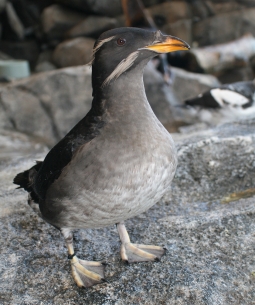Alaska Species Explorer
All
x
- – No known individuals remaining.
- – Known only to survive in captivity, or as a naturalized population outside its historic range.
- – Extremely high risk of extinction in the wild.
- – High risk of extinction in the wild.
- – High risk of endangerment in the wild.
- – Likely to become endangered in the near future.
- – Lowest risk. Does not qualify for a higher risk category. Widespread and abundant taxa are included in this category.
- – Not enough data to make an assessment of its risk of extinction.
- – Has not yet been evaluated against the criteria.
Rhinoceros Auklet
- – No known individuals remaining.
- – Known only to survive in captivity, or as a naturalized population outside its historic range.
- – Extremely high risk of extinction in the wild.
- – High risk of extinction in the wild.
- – High risk of endangerment in the wild.
- – Likely to become endangered in the near future.
- – Lowest risk. Does not qualify for a higher risk category. Widespread and abundant taxa are included in this category.
- – Not enough data to make an assessment of its risk of extinction.
- – Has not yet been evaluated against the criteria.
Range widely across the Northern Pacific. They breed from the Aleutians south to central California and winter off breeding grounds and south to southern California; they also winter in Asia.
The total population is estimated at 2-3 million, but further information is limited about this secretive species. The populations is of low concern but the following recommendations for population management have been made monitor, reduce human impact at nesting sites, maintain predator removal programs, and minimize the occurrence of fuel and oil spills near breeding sites.
It is drab-gray overall, darker above than below. In breeding plumage, the Rhinoceros Auklet has a bright orange-yellow bill adorned with a whitish horn. It also has two light feather tufts on each side of its head, going in a line back from the eye and the corner of the mouth.
Nesting occurs on offshore islands throughout the temperate waters of the North Pacific. Males and females dig burrows with their bills and long, sharp claws. The burrows are usually dug in deep soil on grassy slopes or beneath forests. If soil is lacking, they will nest in crevices or natural cavities.
- Closer relative to the puffin rather than the plankton-feeding alcids called auklets
- Returns to burrows and feeds young at night
- The only nocturnal auklet that carries fish externally. All of the other nocturnal auks bring food in a gular pouch in the throat.














